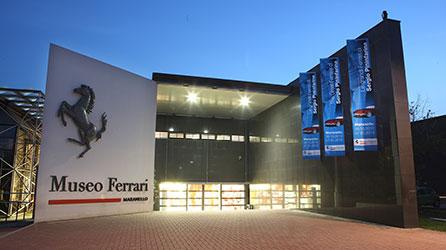
Museum
Opened in 1990, the Museo Ferrari in Maranello exceeded the outright record of 250,000 visitors in 2012. It offers the ideal journey through the history of the company, displaying the most significant cars from the past, all the way through to the road going cars of today and technological content relating to Formula One. Apart from the section used for the permanent displays, there are areas periodically used for new and important exhibitions dedicated to current events and great moments from Ferrari’s history. From May 2013, the Museum is being extended with a new wing measuring over a thousand square metres, providing further display space and a hall given over to educational activities for school children, a semi-professional F1 simulator and specific area for events, conventions and private and exclusive lunches and dinners.
Car assembly
The New Assembly Line building, designed by Jean Nouvel, brings together technological excellence with the highest level of artisanal skill. It is split into two levels for the assembly of the 8 and 12 cylinder cars respectively. This building is the location for significant technological innovation which allows for the best ergonomics when at the work station, eliminating the more tedious tasks which require no specific skills from the workforce. However, those tasks that do require specific professional skills and manual dexterity to ensure the artisanal nature of Ferrari cars and are a key characteristic of our product, have been retained.
Atelier
Since 1997, Ferrari has offered its customers the chance to personalise their cars to make each one unique, a very successful service, so much so that today, 100% of the cars produced feature at least one element of personalisation. Since it opened in 2008, Maranello’s Atelier has contributed to producing cars that are unique because of the exclusive way they are fitted out. When customers come to the factory they can seek the advice of a Ferrari consultant in helping them define the specification, the choice of details and look at ways of enhancing the appearance and equipment.
Tailor-Made
Ferrari Tailor-Made is an exclusive programme offered by the Maranello company, for customers who wish to define the look of their car, thus strongly expressing their own personality and tastes. The Tailor-Made programme follows a tradition in Maranello that dates back to the 50s and 60s, an era when cars could be personalized with great freedom of choice in terms of materials, leather, marquetry, colours and finish. It was a prestigious past that has been reprised today with the possibility to define every aspect of one’s Ferrari right down to the smallest detail, from the bodwork colour to the upholstery in the cabin, as well as the choice of finish and accessories with a range of different materials, treatments and tones never seen before.
Ferrari Classic
The Ferrari Classiche department, which was set up in July 2006, provides a restoration and repair service. Furthermore, thanks to a technical-historic archive, in which can be found all the data, a dedicated panel of experts is capable of evaluating the technical characteristics of all historic cars and their origins, thus being able to authenticate the cars by producing a legal certificate verifying its heritage and ownership. Thanks to Ferrari Classiche, collectors today can entrust their cars to the people best qualified and who can work with the best tools to ensure a state of the art restoration and provide technical assistance for historic Ferraris.
Engine assembly
There are three engine assembly areas: one for the 6 cylinder Maserati, another for the 8 cylinder engines and another for the V12 Ferraris. On the 8 cylinder line, both Ferrari and Maserati 8 cylinder engines are assembled. The engines to be assembled travel on a shuttle followed by a trolley with the components that are fitted one at a time. In the new 6 cylinder Maserati area, a sophisticated robot assembles the cylinder heads automatically. At the end of the line, it’s time for the first checks of the complete engines, before they are run on the test bed.
